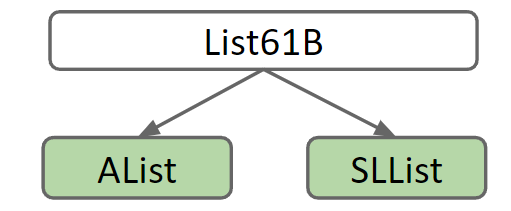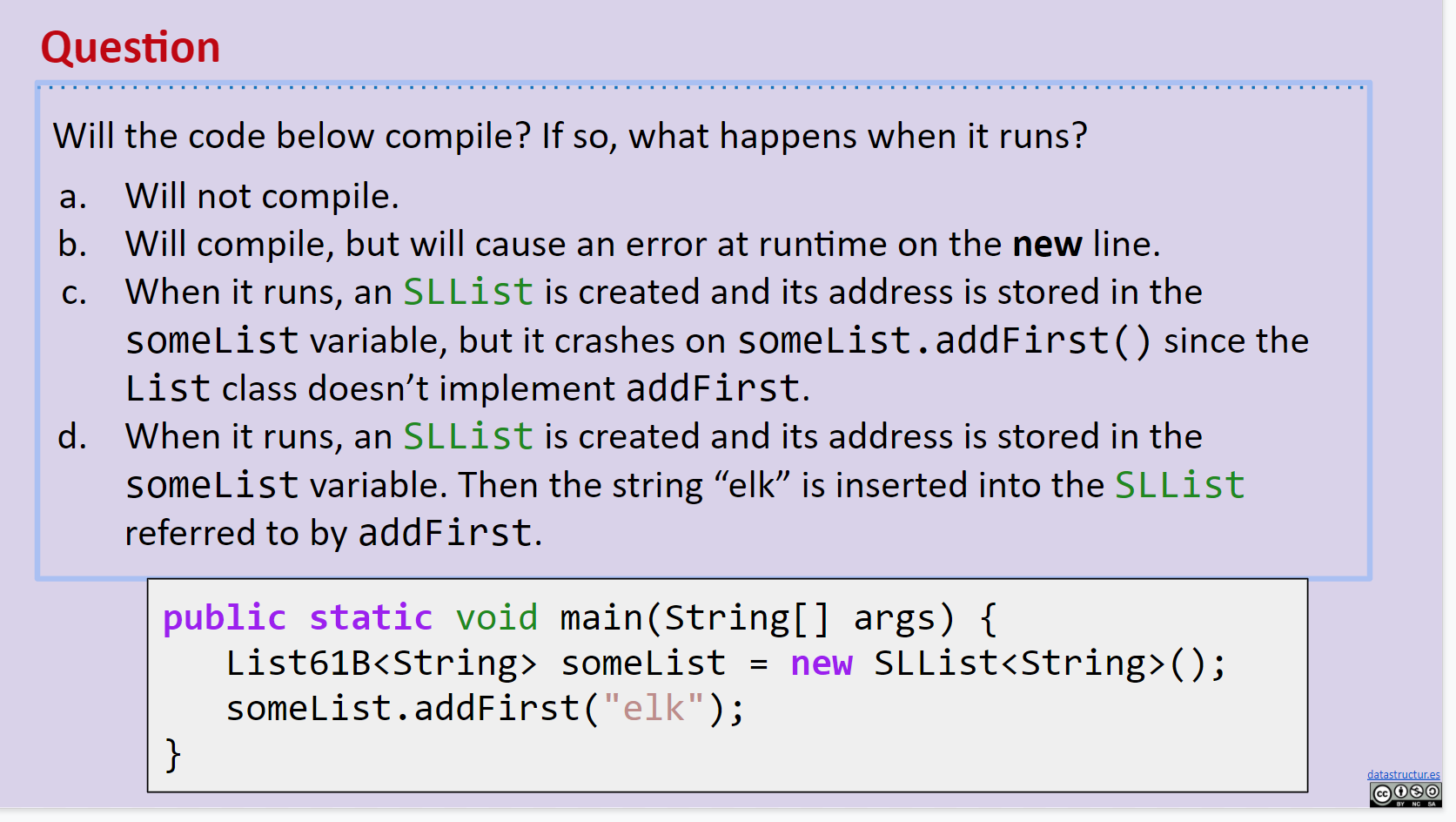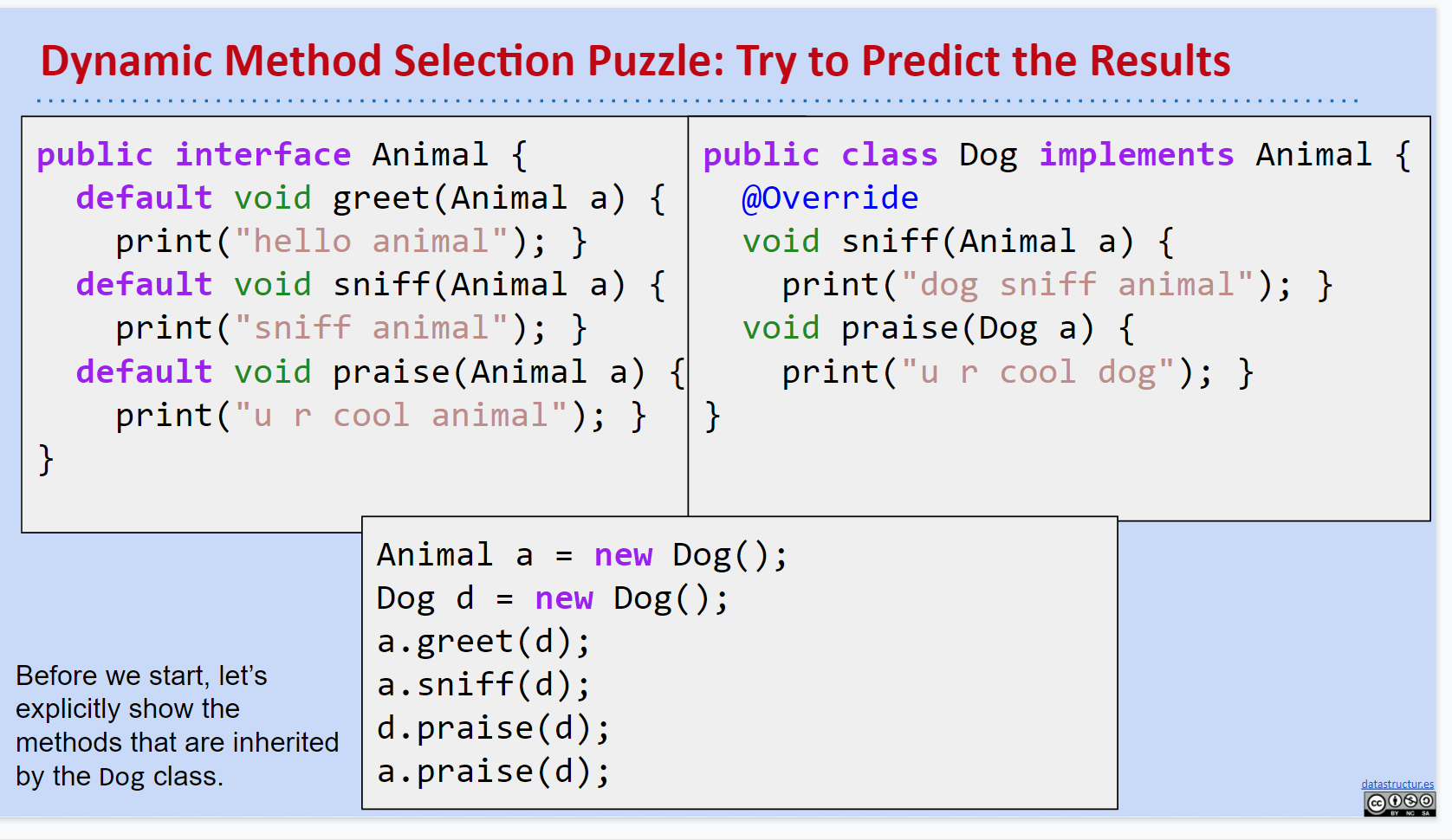8.1 Method Overloading in Java
JAVA 允许函数重载
PS:其实不算一节,但是可以引出下面的内容
但是重载有时候不够优雅:
- Code is virtually identical. Aesthetically gross.
- Harder to maintain.
- Any change made to one ,must be made to another
- Including bug fixe
- Repeating youself
- Won’t work for future lists. If we create a QList class, have to make a third method.
如何优雅的解决问题:使用 Inheritance 继承
8.2 Hypernyms, Hyponyms, and Interface Inheritance
开始要梳理两个词汇:
Hypernyms:上位词
Dog is a “hypernym” of poodle(卷毛犬,贵宾),malamute(爱斯基摩狗,雪橇犬),yorkie(约克夏,TBBT 里的小桂子).
Hyponyms : 下位词
Hypernyms / Hyponyms 是一个所谓的 “is-a” 关系
那么如何在 java 里体现以上的这样的关系:

- Step 1: Define a reference type for our hypernym (List61B.java).
- use interface instead of class
public interface List61B<Item> {
public void insert(Item x, int position);
public void addFirst(Item x);
public void addLast(Item x);
public Item getFirst();
public Item getLast();
public Item get(int i);
public int size();
public Item removeLast();
}- Idea: Interface is a specification of what a List is able to do, not how to do it.
- Step 2: Specify that SLLists and ALists are hyponyms of that type.
- Use the new implements keyword to tell the Java compiler that SLList and AList are hyponyms of List61B.
public class AList<Item> implements List61B<Item>{8.3 Overriding vs. Overloading
要区分 Overriding 和 OVerloading :
- If a “subclass” has a method with the exact same signature as in the “superclass”, we say the subclass overrides the method.
- • Methods with the same name but different signatures are overloaded.
PS:不是很难区分的概念
the @Override Annotation
使用 @Override 注解,帮助书写代码
Why use @Override?
- Main reason: Protects against typos.
- If you say @Override, but it the method isn’t actually overriding anything, you’ll get a compile error.
- e.g. public void addLats(Item x)
- Reminds programmer that method definition came from somewhere higher up in the inheritance hierarchy.
8.4 Interface Inheritance

8.5 Implementation Inheritance: Default Methods
总而言之:我就要在接口里写 how to do 的代码!
Use the default keyword to specify a method that subclasses should inherit from an interface.:
package lec8_inheritance1;
public interface List61B<Item> {
public void insert(Item x, int position);
public void addFirst(Item x);
public void addLast(Item x);
public Item getFirst();
public Item getLast();
public Item get(int i);
public int size();
public Item removeLast();
**default public void print() {
for (int i = 0; i < size(); i += 1) {
System.out.print(get(i) + " ");
}**
}
}当然这也引入了新的问题:比如对 SLList 来说, print() 方法就不那么高效。
所以为了防止有这样的情况发生:我们可以 Overriding Deafault Methods
public interface SLList<Item> implements {
@Override
public void print() {
for (Node p = sentinel.next; p != null; p = p.next) {
System.out.print(p.item + " ");
}
System.out.println();
}
}8.6 Static and Dynamic Type, Dynamic Method Selection
本节讲了: “compile-time type” 和 “run-time type”的区别
Every variable in Java has a “compile-time type”, a.k.a. “static type”.
- This is the type specified at declaration. Never changes!
Variables also have a “run-time type”, a.k.a. “dynamic type”.
- This is the type specified at instantiation (e.g. when using new).
- Equal to the type of the object being pointed at.
Suppose we call a method of an object using a variable with:
- compile-time type X
- run-time type Y
Then if Y overrides the method, Y’s method is used instead.
- This is known as “dynamic method selection”.
8.7 Signature Selection,Dynamic Method Selection
做下面的题(坑非常多)


- At compile time: We determine the signature S of the method to be called.
- S is decided using ONLY static types.

• At runtime: The dynamic type of the invoking object uses its method with this exact signature S.

8.8 Interface vs. Implementation Inheritance
Interface Inheritance (a.k.a. what):
- Allows you to generalize code in a powerful, simple way.
Implementation Inheritance (a.k.a. how):
- Allows code-reuse: Subclasses can rely on superclasses or interfaces.
- Example: print() implemented in List61B.java.
- Gives another dimension of control to subclass designers: Can decide whether or not to override default implementations.
Important: In both cases, we specify “is-a” relationships, not “has-a”.
- Good: Dog implements Animal, SLList implements List61B.
- Bad: Cat implements Claw, Set implements SLList.
Particular Dangers of Implementation Inheritance
- Makes it harder to keep track of where something was actually implemented (though a good IDE makes this better).
- Rules for resolving conflicts can be arcane. Won’t cover in 61B.
- Example: What if two interfaces both give conflicting default methods?
- Encourages overly complex code (especially with novices).
- Common mistake: Has-a vs. Is-a!
- Breaks encapsulation!
- What is encapsulation? See next week.
要区分好 “is a ” 和 “has a “的关系,防止代码的混乱